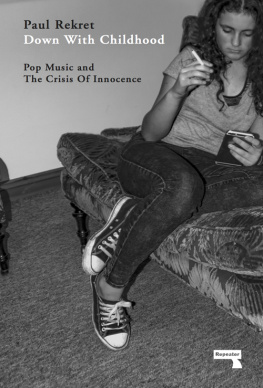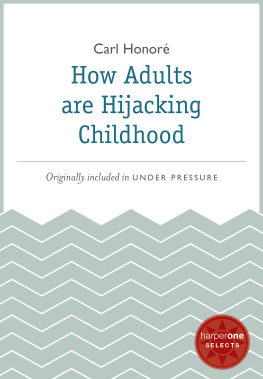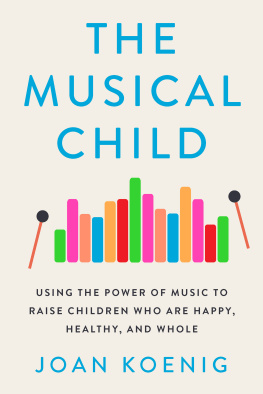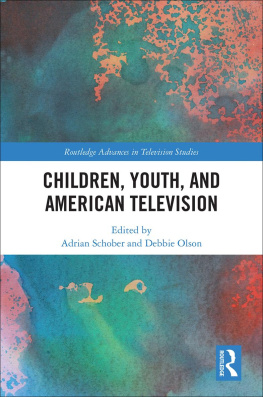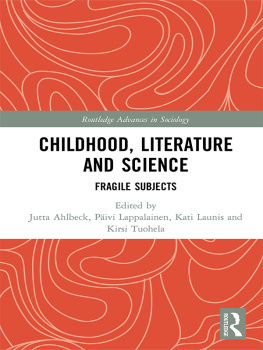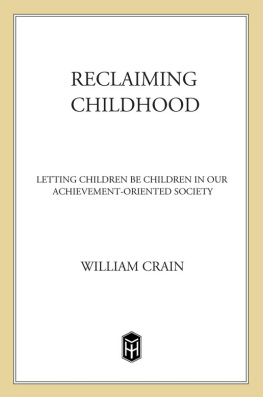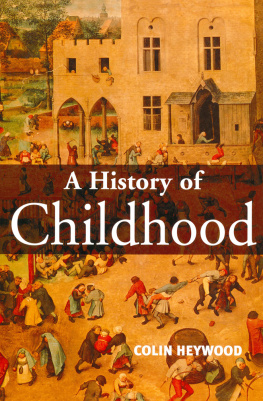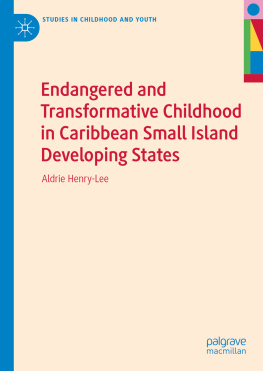Down With
Childhood
Pop Music and
the Crisis of
Innocence
Down With
Childhood
Pop Music and
the Crisis of
Innocence
Paul Rekret
To Yung, with thanks for the wild palms.
Contents
1 All That is Holy is Profaned
With their sweet round mouths sing Ha, ha he!
William Blake, Laughing Song
Cheeks are pinched, hair is tousled, large arms wrap tentacle-like around compact bodies. Children, its fair to say, are solicited to social ideals of childhood. They are frequently asked to assume a pose of vulnerability, of purity, and of innocence. These are traits free of attributes and they no doubt make great demands on even the most skilled actors. Nor is this all. Children are all too often asked to be free of pretensions, to be passive, and to be acquiescent. But at the same time they should not appear too eager to please. Sometimes, children are asked to sing.
This is admittedly all too opaque a set of opening formulations, but they will do for now. Suffice it to say the appeal for the child to sing sets this book into motion. Still, we can glimpse a further indication of whats at stake by looking instead to some of our subjects more uncanny moments.
In the mid-1970s Hans Fenger, a young Canadian music teacher, recorded to two-track tape his sixty-odd music students under the name the Langley Schools Music Project. The results of Fengers populist rejection of the music curriculum are striking. Accompanied only by the sparsest instrumentation, children sing choral versions of pop hits since sacrificed to the constituencies of classic rock.
Fenger and company slacken the tempo of the Beatles The Long and Winding Road to such a slow crawl that, by comparison the already turtle-esque patience of the original sounds raucous. Pared down here to a lonely piano, the melody is anchored around a single young voice turned up, brought to the foreground, as it traipses through the songs phrases with a dainty determination that recalls riding a bicycle for the first time, learning to read, or struggling to remember ones lines in the school play.
The students falter frequently whilst crooning well beyond their vocal range. Indeed, with admirable abandon they shriek the catching choruses to Fleetwood Macs Rhiannon, Neil Diamonds Sweet Caroline, and Wings Band on the Run. Theres a sense of urgency thats absent on the originals.
Cymbals crash a split second out of time, voices frequently come in and out of tune. The amateurish imperfection only makes the invitation to sing along to well-known lyrics more democratic and irresistible.
The solicitation is particularly compelling on a version of the Beach Boys ballad God Only Knows. This is a song whose declaration of love is so cloying only Brian Wilsons reputation for awe dispels the cynicism the lyrics summon. Yet in reducing the tune to solitary acoustic guitar and xylophone, and by over-emphasising and extending the vocal high notes, the children effect tenderness and wonder more commanding than Wilson ever attained.
The initial 1976 private pressing of the album was all but totally ignored. Indeed, popular culture only made room for Fengers students among its ranks by way of the minor success of its 2001 reissue under the mawkish title Songs of Innocence and Despair. The re-release suited the then budding millennial retro-culture, often more interested in musics past than its present or its future.
Critics have usually read this backward-looking mania as symptomatic of a pessimistic cultural epoch, but the Langley Schools Project also stands for more than only a collapsing musical imaginary. In fact it forms a doubly nostalgic act: a cultural operation that frames the Sixties as a series of kitsch tropes of juvenile folly long since outgrown; and through its young chorus of the ideal of childhood innocence.
There is an oedipal theatre at work here, and it operates by unmooring the image of the child from experience to seize it as a stable and frictionless object. This is to say that the ideal of childhood as a time of innocence exists within a complex of adult desires, and its within this knotty assembly that this books central questions lie: what effects does the childs voice, housed in pop songs, produce? What desire does this pop-musical code draw upon when it does its work? And what can it tell us about the changing relationships we form with children? Just to be perfectly clear then, this is a book about childrens voices in pop music.
A State of Exile
An admittedly idiosyncratic subject for sure, but as far as aesthetic economies go, the childs voice condenses more than its fair share of tensions. For one, child-rearing has for quite some time now been the province of the family, and the child a symbol of domesticity. Of course, these associations have a gendered dimension and have long been exploited to consign women to unpaid domestic labour and childcare. Still, the association of childhood with home life also does more than this: it places the child within a haven of security, pleasure, and play, opposed to the real world of work, toil, and ennui.
This is for the childs own good. But it has a tendency to evacuate childhood of content, to consider the child as unencumbered by the emotional baggage acquired in the passage through life. This is among the founding ideas of modern culture and it demands more unpacking.
It bears pointing out at this early juncture that the association of children with pleasure and play has also placed them at the intersection of another pivotal binary of the modern world: between what is natural and what is the product of culture. An inclination to identifying childhood with nature (evident in a still current fondness for images of children with animals) sees it as a site where a pre-modern, older culture is preserved. This is as evident where popular music is imbued with a primal energy as when it is described as having a childlike quality.
These are clichs for sure, but they betray a view of childhood as a primitive, sensuous and spontaneous state of being ever at the threshold of inevitable displacement by a mature rational disposition. Were amongst a peculiar set of desires here and theyre often articulated in the form of maxims: let children be children; but everybodys got to grow up sometime.
This belies strained beliefs and these, in turn, imply still other frictions. Some of these can be found in the childs voice. In physiological terms the difference between the voice of an adult and that of a child amounts to the latters higher larynx and shorter vocal tract. Shorter and thinner vocal folds mean the dynamic contrast young people produce is less than the average adult, and entails a more limited pitch range and a lower capacity for vocalisations that are long, agile, or rich.
But not only are such anatomical differences mere averages, they have nothing to say of the meanings and affects engendered by the voice of a child. Physiology is of limited use here, but so too are more formalist strands of musicology, given their attachment to the purity of tone. Were better served by Roland Barthes counsel to contemplate what he calls the grain of the voice. No notation exists to signify vocal timbre or texture, the smacking of a tongue or a slight lisp. These are all irreducible to musical formulation and refer instead, as Barthes has it, to the body in the voice as it sings.
To pose the question of the voice then is to query a broad series of coordinates or, put otherwise, to confront expression in excess of meaning. But it also entails tackling another founding distinction of Western civilization: between animal sound and meaningful speech.
For millennia philosophers have defined what is distinctly human upon this division, between what they call phone (sound) and
Next page
